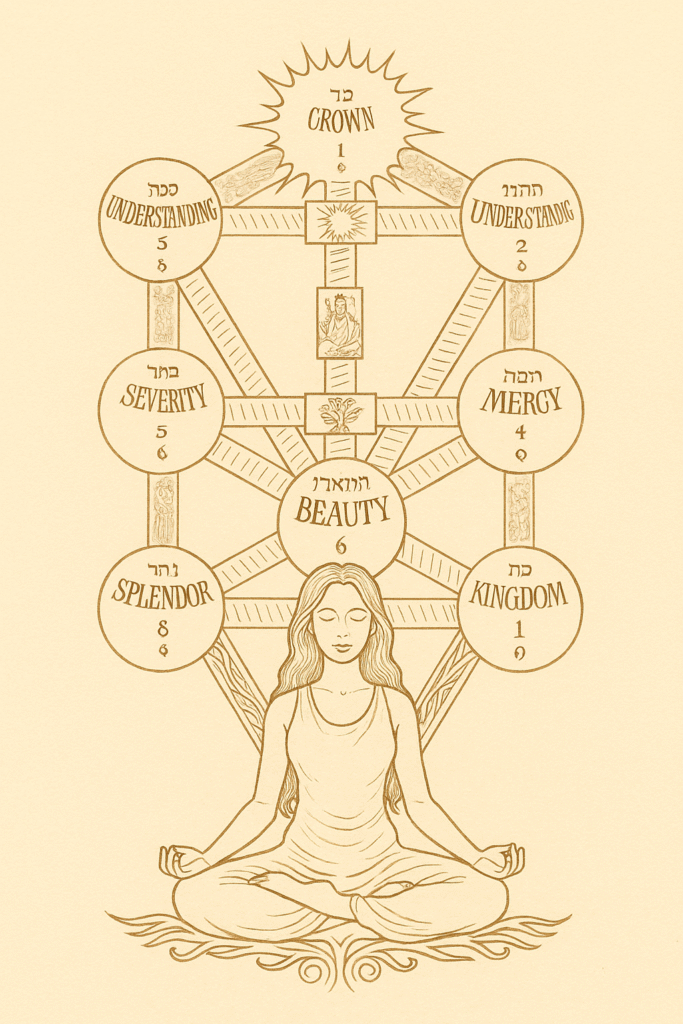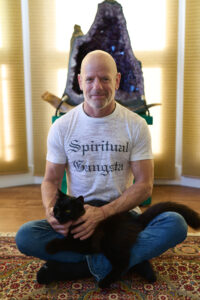Kabbalah & Yoga:A Soulful Dialogue About Cables and Yokes

I was recently listening to an academic lecture on the history of yoga. As you know, many yoga classes and teacher trainings lean into the mythology of yoga’s origin — in one Kundalini class, the teacher claimed yoga was 10,000 years old. This romanticizing is part of the current zeitgeist: a surge of nationalism that has even seeped into spirituality and religion. We see this in Christian nationalism, Hindu nationalism, Jewish nationalism — and in some corners of Kabbalah, where claims such as “angels speak Hebrew,” (seriously?) “Hebrew is the oldest language,” (it’s not) or “Moses wrote the Torah” (he didn’t) circulate unchecked. For instance, some assert that Rabbi Shimon bar Yochai wrote the Zohar in the 2nd century CE rather than in the 13th century, when scholars agree it was composed by Moshe de Leon. Myths don’t just run in families—they thrive in tribes and traditions.
Some History
While the histories of yoga and Kabbalah are often hazy, we can spot meaningful parallels. So let’s travel through time.
Between 1800 and 1500 BCE, the Indo-Aryans settled in the Indus Valley and Ganges Plain. This period offers us the earliest layers of Sanskrit scripture: the Vedas, a compilation of hymns and ritual formulas. Significantly, the Vedas do not explicitly mention reincarnation or past lives as we now conceive of them. I find a similarity between the Vedas and the ritual-heavy portions of the Old Testament (for example, Leviticus and Deuteronomy), texts we know were heavily edited, rendered, and manipulated by priestly communities over time, in an attempt to control and profit from their subjects.
Yoga, under that name, appears primarily in the Rig Veda, but its meaning is closer to “breath, prana, sense-control” rather than the modern flowing asana practice. (See Larson et al. on the Upanishads and Yoga). It is only in the Upanishads, compiled around the mid-1st millennium BCE, that yoga begins to dress herself appropriately: a path of self-realization and liberation, of transcending mind and senses to merge with the ultimate reality (Brahman).
At roughly the same time, following the destruction of Solomon’s Temple in Jerusalem and the subsequent exile to Babylon (6th century BCE), we see the emergence of mystical currents in Jewish tradition (which later became what we call Kabbalah). For instance, the so-called “chariot mysticism” (Merkava) emerges, inspired by the vision of Ezikel or a chriot landing from the sky (yes, some believe it was a spacecraft, read for yourself)
This era – roughly 800-300 BCE – has been dubbed the “Axial Age” (according to philosopher Karl Jaspers): China (Lao Tzu, Confucius), India (Buddhism, Jainism, Upanishads), Judea (prophets, Hebrew Scripture written), Ancient Greece (Pythagoras, Socrates, Plato, the Iliad & Odyssey) and Persia (Zoroastrianism). An interesting observation, Physagoras established the first esoteric school and taught the doctrine of reincarnation. Therefore, the belief in the transmigration of the soul is not Eastern or Western but global.
In the Axial Age, the Earth herself took the form of an asana, and humanity made a quantum leap into transcendental consciousness.
In this Axial Age, both yoga and Kabbalah were taking shape. In yoga, we find meditation, self-control, inner journeying; in Kabbalah, the notion of the Merkava, the chariot, appears. In Kabbalistic literature, the chariot becomes a symbol of meditation: the ability to journey inward, travel without moving. “God is no longer in Jerusalem; He is everywhere.” One need only sit still (Hitbodedut), closed eyes, and harness, tame, yoke the senses and drive them inward. In the Upanishads, the same advice: abandon endless convoluted external rituals, turn inward—discover the God-within rather than outside.
Both yoga and Kabbalah then continued to evolve as practitioners went on inner-world hero-journeys, returning with new ways of viewing life: more mystical, more focused on the unity of mind, body, and soul. Early yogis and early Kabbalists reported that death is not the end, that our souls are on a journey (lifetime after lifetime), working to burn karma (action/reaction) and perform tikkun (soul-rectification). We are still using their techniques all these centuries later, enjoying the elixirs they concocted.
Meaning of the Name
The word “Kabbalah” means “to receive” or “to accept” (you must accept to receive). Using the Tree of Life as a metaphor, Kabbalah invites us to become a conduit (a cable) between the above and the below, the divine and the mundane.
In Yoga, we have Isa and Pingala, the two snakes that intercross 7 times around our spinal cord (seven chakras). In the Kabbalistic Tree of Life, we have seven sefirot (levels) and two pillars that hug a central column of balance.
Yoga’s etymology leads to the Sanskrit root yuj, meaning “to yoke, to join, to harness, to tame, to control.” So, in essence, both doctrines strive for the same goal: oneness, union.
In yoga, we have asanas (postures or positions), some of which are named after animals (cobra, dog, cat, cow, crow, camel, etc.). In Kabbalah, it is believed that God created the universe with 22 “asanas” (letters), each mapped to an archetype. Some of those letters are also animal-based: Gimel = camel. In Kabbalah we have the four “animals” (Hayot) that support the Throne of God.
What made me pause and write this email was the connection I found between Kabbalah and Yoga regarding breath.
Alef – Air – Breath
The Hebrew alphabet traces its origin to the world’s first phonetic alphabet, most likely created by the Phoenicians. This Canaanite culture arose in the Levant (modern-day Lebanon) and sailed across the Mediterranean, spreading their language and symbols. In fact, even Spain owes its name to them: the Phoenicians called the Iberian Peninsula I-Shaphan-im, “the land of rabbits.”
The Hebrew and Phoenician alphabets share the same DNA — the shapes, names, and sounds of their letters reflect their meanings. For instance, the second letter, Bet, means house and even resembles one. Vav (ו) means hook or nail, it both looks and sounds like the word and (Ve), joining things together. The first letter, Alef, gives us the origin of the very word alphabet — from Alef and Bet — the beginning of all beginnings.
The Hebrew Letter Alef, origin of Alpha and A.
Alef carries many meanings in Hebrew. It means “to tame” or “harness” and also represents the ox — the first animal domesticated to pull wagons. In Kabbalah, Alef is one of the three Mother Letters, each linked to an element: Mem to water, Shin to fire, and Alef to air or breath — prana. It also means “champion” (Aluf) and a “thousand” (Elef). Symbolically, Alef embodies the thought before it is spoken, the silent spark preceding expression. The second letter, Bet, represents the word or logos that houses this divine thought. That is why the Bible begins with Bet and not Alef.
Put together – you want to be a champion (Aluf)? No worries, tame your senses (Alef), and practice the asanas of Yoga – that would lead you on the path to oneness.
The Chariot
As mentioned above, in Kabbalah, the Chariot represents meditation, a vehicle of transcendence. In the Tarot’s symbolic system, the Chariot corresponds to the zodiac sign Cancer, the sign of the womb, motherhood, and family. Makes sense? After all, each of us once meditated for nine months in our mother’s womb, traveling everywhere she went without moving — the very definition of meditation.
Interestingly, the Katha Upanishad (for example) uses the chariot metaphor: the Higher Self (Atman) is the passenger, the body is the chariot, and the horses are the five senses that must be controlled. Literally, the senses have to be Alef (tamed) for us to move forward in our spiritual journey. Alef = breath, air but also control. Control of breath tames the senses. Instead of projecting our shadows onto others, we must look inward, hold the reins of our senses, and ride ourselves toward awareness. 
Final thought:
Yoga and Kabbalah are not disconnected spiritual streams; they are, in many ways, siblings on the same mystical landscape. Both remind us: the journey inward is the portal to transcendence.
Thank you for reading…
I’d love to hear your thoughts: which part of this journey resonates with you? Are you more drawn to the breath-control of yoga or the letter-mysticism of Kabbalah? Let me know.
Recommended reading: Yoga Roots by Professor (and yogi) James Mallinson
